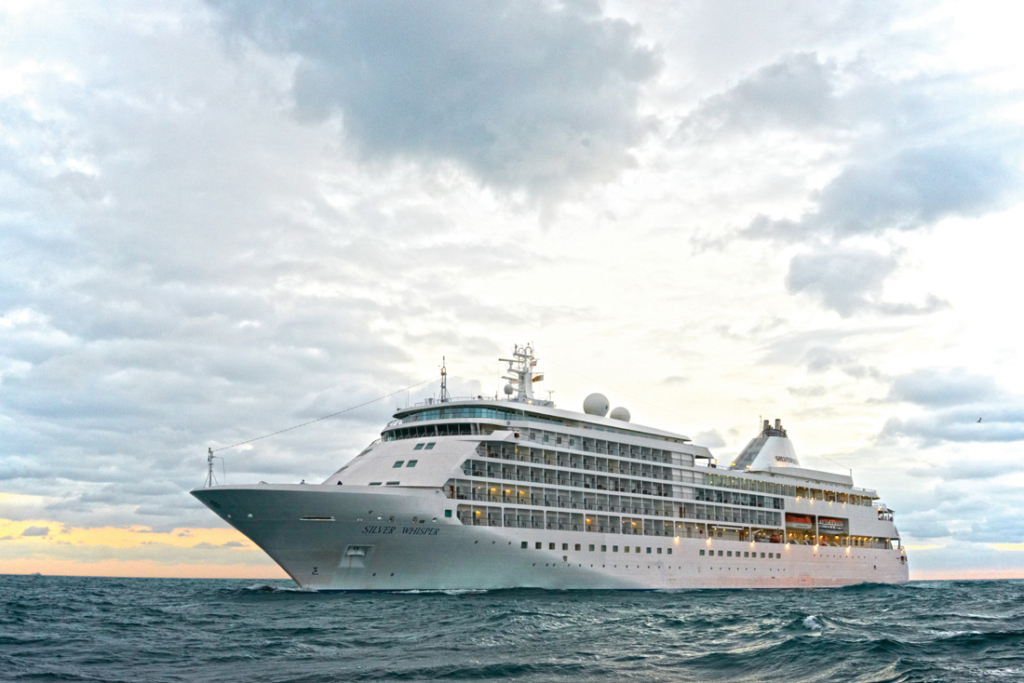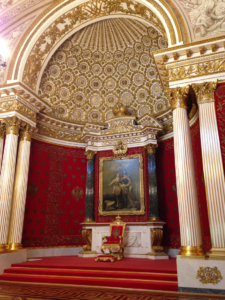A 5-day cruise on the Silver Whisper.

Travel is as much about the journey as the destination. My travel buddy, Patty Ellis, and I remembered that mantra as we dragged our jet-lagged selves aboard the Silversea Cruise Line’s Silver Whisper after a 15-hour flight from Atlanta to Stockholm. To our delight, we were greeted by smiling butlers carrying flutes of chilled Champagne. It marked the beginning of what would be a remarkable cruise on the Baltic Sea to Estonia, Russia and Finland.
ALL ABOARD: DAY 1
One of the reasons we chose the Silver Whisper was its size. With a capacity of about 390 passengers and a crew of 303, it’s much smaller than the typical ocean-going ships. Our cabin was on a par with a five-star hotel, featuring two queen beds, a sitting area, desk and walk-in closet. The opulent marble bathroom had a large tub, glassed-in shower and double sink. The amenities throughout the ship were equally as posh with crystal chandeliers in restaurants and three gourmet meals daily. But the pièce de résistance was our private butler, Dipok, a charming young man who fulfilled our every request, including breakfast in the room each day.
DAY 2
Our adventures began on day two when we docked in Tallinn, Estonia, the oldest capital city in northern Europe that dates back to the thirteenth century. As we strolled through the enchanting half-mile square village atop a cliff, we marveled at the well-preserved cobblestone streets, churches and cottages. Sections of the original stone walls are flanked by watch towers worthy of Rapunzel’s long locks.
DAYS 3, 4 AND 5

When we opened the curtains of our picture window on the third morning, Saint Petersburg lay at the end of the pier. The planned city was commissioned in the early 1700s by Tsar Peter the Great who wanted his city to outshine European capitals and became obsessed with Paris and Versailles. The outcome is a spectacular array of architectural styles from both East and West.
Our first excursion was to the Hermitage, the most famous of the St. Petersburg palaces and formerly the Winter Palace of Russian tsars. The enormous green and white Baroquestyle building lies on the banks of the Neva River, and the amount of gold leaf décor in the interior is blinding. Mouths agape, we walked through the near replica of Versailles, complete with gold-framed mirrors, intricately decorated ceilings, floors inlaid with semi-precious stones and a massive collection of priceless art works from all over the world.
After a traditional Russian lunch we traveled by bus to the Fabergé Museum in the Shuvalov Palace. It houses the second largest collection of original Imperial Easter eggs in Russia and boasts gallery after gallery of Impressionist paintings.
Russia has, on average, only 60 days of sunshine, and we happily experienced three. Good weather was critical the following day when we visited the Peterhof, Peter the Great’s Summer Palace. Located an hour’s ride from the city center, the interior was as opulent and gilded as the Hermitage, but the 500 acres of forests, gazebos, meticulously manicured gardens and impressive fountains surpass even Versailles. The centerpiece is the Great Cascade, a series of more than 140 fountains and canals behind the palace. At 11 a.m. it erupts into a fanciful water dance to the strains of “Anthem to the Great City.” Breathtaking.
On our last day in St. Petersburg, we traveled by tour bus 30 miles outside the city to Pushkin to visit Catherine Palace, reputed to be the longest palace in the world. The most outstanding feature was the Amber Room, “wallpapered” in semi-precious amber stones with gold leaf trim.
DAY FIVE
After an overnight sail on calm waters, we arrived in Helsinki, Finland. Although we didn’t get to see the Northern Lights, we did experience the midnight sun that occurs during the summer months when the light shines until midnight.
Following the glory of St. Petersburg, Helsinki was a bit of a letdown, despite the lively guide who claimed that during the frigid winter months, Finns drink more coffee and vodka per capita than any place in the world. We didn’t know what to expect at The Church of the Rock (aka Temppeliaukio), but it proved to be an architectural wonder. Excavated directly into solid rock and capped with a copper-lined dome, it felt both mystical and holy. Just before noon, the sunlight spread from the row of windows encircling the rugged interior and filled it with a golden light as bright as the gild in the Russian palaces. Another highlight was shopping in the open-air market where we purchased paintings by local artists, amber jewelry and some reindeer cutlery.
Our last day onboard was spent on the open sea, and we sipped wine on the observation deck and talked to new-found friends as the Silver Whisper headed to Copenhagen. It was a perfect ending to a perfect voyage.
CRUISE CONTROL
Cruises sail the Baltic from May to September, but the optimal time is June and July before the rainy season. n Book six months to a year in advance for special rates.
Plan to arrive a day early in Stockholm and stay over at least a day in Copenhagen. We wished we had.
Apply for a Russian visa 90 days in advance if you want to explore on your own without a tour group. The process is complex, and the cost is $160 plus a processing fee.
Unlike most ship lines, tips for the staff are included in the cruise price, which starts at $3,500.
For more information: silversea.com.
STORY: Mickey Goodman

















